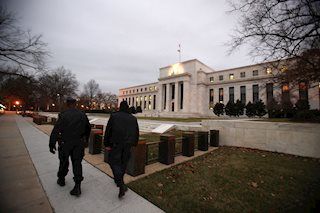When is the Fed interest rate decision and how could it affect DXY?
|
The Federal Reserve will announce its decision at 19:00 GMT. Jerome Powell will hold a press conference at 19:30 GMT. Starting today, every FOMC meeting will be followed by a press conference and only those meetings associated with the release of the Summary of Economic Projections.
Key notes
The Federal Reserve is widely expected to keep policy on hold. The rate stands at 2.25 - 2.5%. Analysts will look for any signals about the future interest-rate path and also for the balance sheet normalization program. Markets’ attention will be on potential changes to the forward guidance. Some changes to the statement are also seen. The slowdown in global growth, the trade wars, geopolitical risks and volatility across financial markets created speculations that the US central bank will shift to a more “dovish” tone.
“Policy will remain unchanged at the January FOMC meeting, but communications will be another matter altogether. The Fed wants to convey a patient, even cautious, data-dependent approach to policy — but without nudging markets in an even more dovish direction, given the gap between Fed projections and market pricing”, wrote analysts at TDS. According to them, the Fed has two options: “keep the statement relatively similar to the one in December, and have Fed Chair Jay Powell convey that the Fed wants to continue supporting the expansion and will react to the incoming data or update the statement to remove the last vestiges of forward guidance and stress data dependence, and have Powell respond to any questions those changes generates." They expect FOMC members to choose a version of the second.
Analysts at Rabobank no longer expect any rate hike this year. The see that the Fed’s patience suggests that they are aiming for a summer hike. “However, recent movements in the yield curve confirm our view that we are getting closer to a recession. Therefore, we doubt that the economic data will be strong enough to build a case for a restart of the hiking cycle. We expect the Fed to put a halt to balance sheet normalization in the second half of the year, once the case for a summer hike has collapsed”; they concluded.
Implications for DXY
The greenback weakened last week after a WSJ article suggested that the FOMC was considering ending to balance sheet normalization program sooner-than-expected. The US Dollar Index dropped sharply that day from 96.50. It bottomed yesterday at 95.63, the lowest since January 15. The slide last Friday, weakened the outlook for the greenback that was on recovery mode.
During the last three days, DXY has remained steady, far from last week highs. Today rose supported by US data but the move higher was capped by 96.00. The bias points to the downside, but if it gains momentums and manages to end the week above 96.40, it would signal more gains ahead. In the short-term, immediate resistance levels are seen at 96.05 followed by 96.20.
If the tone of the Fed turns out to be more dovish than what markets are expecting, it would be negative for the greenback. The near support is at 95.70, below that level the bearish pressure is likely to intensify. The next support might be seen at 95.50 followed by 95.25.
About the interest rate decision
With a pre-set regularity, a nation's Central Bank has an economic policy meeting, in which board members took different measures, the most relevant one, being the interest rate that it will charge on loans and advances to commercial banks. In the US, the Board of Governors of the Federal Reserve meets at intervals of five to eight weeks, in which they announce their latest decisions. A rate hike tends to boost the local currency. A rate cut tends to weaken the local currency. If rates remain unchanged (or the decision is largely discounted), attention turns to the tone of the FOMC statement, and whether the tone is hawkish, or dovish over future developments of inflation.
About the FOMC statement
Following the Fed's rate decision, the FOMC releases its statement regarding monetary policy. The statement may influence the volatility of USD and determine a short-term positive or negative trend. A hawkish view is considered as positive, or bullish for the USD, whereas a dovish view is considered as negative, or bearish.
Information on these pages contains forward-looking statements that involve risks and uncertainties. Markets and instruments profiled on this page are for informational purposes only and should not in any way come across as a recommendation to buy or sell in these assets. You should do your own thorough research before making any investment decisions. FXStreet does not in any way guarantee that this information is free from mistakes, errors, or material misstatements. It also does not guarantee that this information is of a timely nature. Investing in Open Markets involves a great deal of risk, including the loss of all or a portion of your investment, as well as emotional distress. All risks, losses and costs associated with investing, including total loss of principal, are your responsibility. The views and opinions expressed in this article are those of the authors and do not necessarily reflect the official policy or position of FXStreet nor its advertisers.